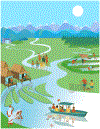Understanding rivers and their social relations: A critical step to advance environmental water management
- PMID: 31827789
- PMCID: PMC6905518
- DOI: 10.1002/wat2.1381
Understanding rivers and their social relations: A critical step to advance environmental water management
Abstract
River flows connect people, places, and other forms of life, inspiring and sustaining diverse cultural beliefs, values, and ways of life. The concept of environmental flows provides a framework for improving understanding of relationships between river flows and people, and for supporting those that are mutually beneficial. Nevertheless, most approaches to determining environmental flows remain grounded in the biophysical sciences. The newly revised Brisbane Declaration and Global Action Agenda on Environmental Flows (2018) represents a new phase in environmental flow science and an opportunity to better consider the co-constitution of river flows, ecosystems, and society, and to more explicitly incorporate these relationships into river management. We synthesize understanding of relationships between people and rivers as conceived under the renewed definition of environmental flows. We present case studies from Honduras, India, Canada, New Zealand, and Australia that illustrate multidisciplinary, collaborative efforts where recognizing and meeting diverse flow needs of human populations was central to establishing environmental flow recommendations. We also review a small body of literature to highlight examples of the diversity and interdependencies of human-flow relationships-such as the linkages between river flow and human well-being, spiritual needs, cultural identity, and sense of place-that are typically overlooked when environmental flows are assessed and negotiated. Finally, we call for scientists and water managers to recognize the diversity of ways of knowing, relating to, and utilizing rivers, and to place this recognition at the center of future environmental flow assessments. This article is categorized under: Water and Life > Conservation, Management, and Awareness Human Water > Water Governance Human Water > Water as Imagined and Represented.
Keywords: environmental flows; environmental water allocations; freshwater; rivers; social-ecological systems.
Conflict of interest statement
CONFLICT OF INTEREST The authors have declared no conflicts of interest for this article.
Figures




References
FURTHER READING
-
- Acreman MC, & Dunbar MJ (2004). Defining environmental river flow requirements—A review. Hydrology and Earth System Sciences, 8(5), 861–876.
-
- Awatere SR, Taura M, Watene-Rawiri Y, Reihana E, Te Maru K, & Harmsworth G (2017). Insights for government, councils and industry Wai Ora Wai Māori—A kaupapa Māori assessment tool. Technical report
-
- CDM Smith. (2016). Environmental flows in Rufiji River Basin assessed from the perspective of planned development in Kilombero and Lower Rufiji Sub-basins. Technical assistance to support the development of irrigation and rural roads infrastructure project (IRRIP2). CDM Smith for USAID/Tanzania.
-
- CDM Smith. (2018). Water for the environment in Tanzania: Environmental flows through reserve implementation in the Rufiji River Basin. Extended Policy Brief. Tanzania: CDM Smith for USAID.
-
- Olden JD, Konrad C, Melis T, Kennard M, Freeman M, Mims M, … Williams J (2014). Are large-scale flow experiments informing the science and management of freshwater ecosystems? Frontiers in Ecology and the Environment, 12, 176–185.
References
-
- Acreman MC, Overton IC, King J, Wood PJ, Cowx IG, Dunbar MJ, … Young WJ (2014). The changing role of eco-hydrological science in guiding environmental flows. Hydrological Sciences Journal, 59(3–4), 433–450.
-
- Amberson S, Biedenweg K, James J, & Christie P (2016). The heartbeat of our people: Identifying and measuring how salmon influences Quinault tribal well-being. Society and Natural Resources, 29(12), 1389–1404.
-
- Anderson EP, Encalada A, Maldonado-Ocampo JA, McClain ME, Ortega H, & Wilcox BP (2011). Environmental flows: A concept for addressing effects of river alterations and climate change in the Andes. Chapter 23 In Herzog SK, Martinez R, Jorgensen PM, & Tiessen H (Eds.), Climate change effects on the biodiversity of the tropical Andes: An assessment of the status of scientific knowledge. San Jose dos Campos and Paris: Inter-American Institute of Global Change Research (IAI) and Scientific Committee on Problems of the Environment (SCOPE).
-
- Anderson EP, Pringle CM, & Rojas M (2006). Transforming tropical rivers: An environmental perspective on hydropower development in Costa Rica. Aquatic Conservation: Marine and Freshwater Systems, 16, 679–693.
Grants and funding
LinkOut - more resources
Full Text Sources
Miscellaneous
